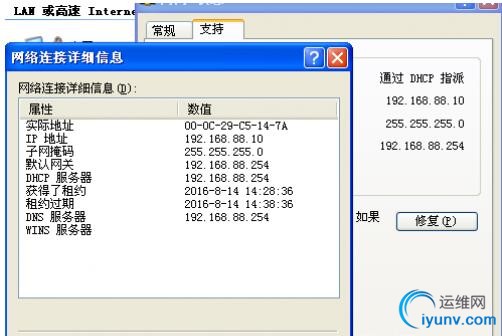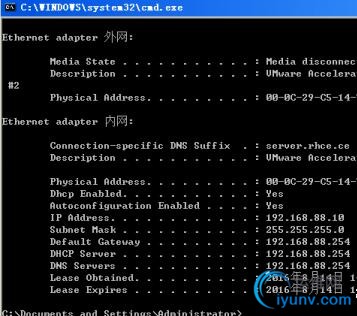|
|
DHCP(Dynamic Host Configuration Protocol,动态主机配置协议)是一个局域网的网络协议,使用UDP协议工作, 主要有两个用途:给内部网络或网络服务供应商自动分配IP地址,给用户或者内部网络管理员作为对所有计算机作中央管理的手段,在RFC 2131中有详细的描述。DHCP有3个端口,其中UDP67和UDP68为正常的DHCP服务端口,分别作为DHCP Server和DHCP Client的服务端口;546号端口用于DHCPv6 Client,而不用于DHCPv4,是为DHCP failover服务,这是需要特别开启的服务,DHCP failover是用来做“双机热备”的。这里借用百度百科DHCP的信息,更多理论参照这个。
实验环境
系统:CentOS 6.5 IP:192.168.88.254
客户端:WinXP
安装软件
Installed:
dhcp.x86_64 12:4.1.1-51.P1.el6.centos //主包
Dependency Updated: //通过yum 安装会解析到依赖包,如果rpm安装记得也安装上去
dhclient.x86_64 12:4.1.1-51.P1.el6.centos
dhcp-common.x86_64 12:4.1.1-51.P1.el6.centos
默认安装完成后配置文件是空的,如
1
2
3
4
5
6
7
| [iyunv@server ~]# cat /etc/dhcp/dhcpd.conf
#
# DHCP Server Configuration file.
# see /usr/share/doc/dhcp*/dhcpd.conf.sample
# see 'man 5 dhcpd.conf'
#
[iyunv@server ~]#
|
通过文件中的说明,告诉我们,在/usr/share/doc/dhcp*/dhcpd.conf.sample 这里有模板文件可能参考。我们直接复制过来
1
2
3
| [iyunv@server ~]# ll /usr/share/doc/dhcp-4.1.1/dhcpd.conf.sample
-rw-r--r--. 1 root root 3262 8月 13 2002 /usr/share/doc/dhcp-4.1.1/dhcpd.conf.sample
[iyunv@server ~]#
|
可以看的,我的DHCP版本是4.1.1,文件的所有者和所属组都是root。
1
2
3
4
5
| [iyunv@server ~]# ll /usr/share/doc/dhcp-4.1.1/dhcpd.conf.sample
-rw-r--r--. 1 root root 3262 8月 13 2002 /usr/share/doc/dhcp-4.1.1/dhcpd.conf.sample
[iyunv@server ~]# cp /usr/share/doc/dhcp-4.1.1/dhcpd.conf.sample /etc/dhcp/dhcpd.conf
cp:是否覆盖"/etc/dhcp/dhcpd.conf"? y
[iyunv@server ~]#
|
dhcpd.conf.sample文件的所有内容如下
1
2
3
4
5
6
7
8
9
10
11
12
13
14
15
16
17
18
19
20
21
22
23
24
25
26
27
28
29
30
31
32
33
34
35
36
37
38
39
40
41
42
43
44
45
46
47
48
49
50
51
52
53
54
55
56
57
58
59
60
61
62
63
64
65
66
67
68
69
70
71
72
73
74
75
76
77
78
79
80
81
82
83
84
85
86
87
88
89
90
91
92
93
94
95
96
97
98
99
100
101
102
103
104
105
| [iyunv@server ~]# vim /etc/dhcp/dhcpd.conf
# dhcpd.conf
#
# Sample configuration file for ISC dhcpd
#
# option definitions common to all supported networks...
option domain-name "example.org";
option domain-name-servers ns1.example.org, ns2.example.org;
default-lease-time 600;
max-lease-time 7200;
# Use this to enble / disable dynamic dns updates globally.
#ddns-update-style none;
# If this DHCP server is the official DHCP server for the local
# network, the authoritative directive should be uncommented.
#authoritative;
# Use this to send dhcp log messages to a different log file (you also
# have to hack syslog.conf to complete the redirection).
log-facility local7;
# No service will be given on this subnet, but declaring it helps the
# DHCP server to understand the network topology.
subnet 10.152.187.0 netmask 255.255.255.0 {
}
# This is a very basic subnet declaration.
subnet 10.254.239.0 netmask 255.255.255.224 {
range 10.254.239.10 10.254.239.20;
option routers rtr-239-0-1.example.org, rtr-239-0-2.example.org;
}
# This declaration allows BOOTP clients to get dynamic addresses,
# which we don't really recommend.
subnet 10.254.239.32 netmask 255.255.255.224 {
range dynamic-bootp 10.254.239.40 10.254.239.60;
option broadcast-address 10.254.239.31;
option routers rtr-239-32-1.example.org;
}
# A slightly different configuration for an internal subnet.
subnet 10.5.5.0 netmask 255.255.255.224 {
range 10.5.5.26 10.5.5.30;
option domain-name-servers ns1.internal.example.org;
option domain-name "internal.example.org";
option routers 10.5.5.1;
option broadcast-address 10.5.5.31;
default-lease-time 600;
max-lease-time 7200;
}
# Hosts which require special configuration options can be listed in
# host statements. If no address is specified, the address will be
# allocated dynamically (if possible), but the host-specific information
# will still come from the host declaration.
host passacaglia {
hardware ethernet 0:0:c0:5d:bd:95;
filename "vmunix.passacaglia";
server-name "toccata.fugue.com";
}
# Fixed IP addresses can also be specified for hosts. These addresses
# should not also be listed as being available for dynamic assignment.
# Hosts for which fixed IP addresses have been specified can boot using
# BOOTP or DHCP. Hosts for which no fixed address is specified can only
# be booted with DHCP, unless there is an address range on the subnet
# to which a BOOTP client is connected which has the dynamic-bootp flag
# set.
host fantasia {
hardware ethernet 08:00:07:26:c0:a5;
fixed-address fantasia.fugue.com;
}
# You can declare a class of clients and then do address allocation
# based on that. The example below shows a case where all clients
# in a certain class get addresses on the 10.17.224/24 subnet, and all
# other clients get addresses on the 10.0.29/24 subnet.
class "foo" {
match if substring (option vendor-class-identifier, 0, 4) = "SUNW";
}
shared-network 224-29 {
subnet 10.17.224.0 netmask 255.255.255.0 {
option routers rtr-224.example.org;
}
subnet 10.0.29.0 netmask 255.255.255.0 {
option routers rtr-29.example.org;
}
pool {
allow members of "foo";
range 10.17.224.10 10.17.224.250;
}
pool {
deny members of "foo";
range 10.0.29.10 10.0.29.230;
}
}
|
可以看到内容是相当多的我,但是有很我#号开头的都是说明,但是我们需要的东西很少
1
2
3
4
5
6
7
8
9
10
11
12
13
14
15
16
17
18
19
20
21
22
23
24
25
26
27
28
29
30
31
| [iyunv@server ~]# vim /etc/dhcp/dhcpd.conf
option domain-name "rhce.ce";
option domain-name-servers server.rhce.ce;
default-lease-time 600;
max-lease-time 7200;
ddns-update-style none;
authoritative;
log-facility local7;
//上面的配置是全局配置,如果在subnet中没有指明则按这个配置。
subnet 192.168.88.0 netmask 255.255.255.0 { //声明一个网段
range 192.168.88.1 192.168.88.250; //声明一个地址段
option domain-name-servers rhce.ce; //声明DNS服务器
option domain-name "server.rhce.ce"; //声明DNS服务器名称
option routers 192.168.88.254; //声明网关
option broadcast-address 192.168.88.255; //广播地址
default-lease-time 600; //默认有效时间600秒
max-lease-time 7200; 最大时间7200秒
}
host passacaglia {
hardware ethernet 0:0:c0:5d:bd:95;
filename "vmunix.passacaglia";
server-name "toccata.fugue.com";
}
host WindowsXP { //为客户端做地址保留
hardware ethernet 08:00:07:26:c0:a5;
fixed-address 192.168.88.10;
}
|
按照上面的配置,我在service dhcpd restart时出错了,查看message发现了一行错误
Can't chown new lease file: Operation not permitted
网上看了好多文章都说是没有权限造成的,在操作过程中发现其实是selinux导致的。并不需要修改/etc/init.d/dhcpd ,我也不觉得修改很我,那样话DHCP就有了root的权限了。
默认情况下是不会出现这样的问题的,我中间也换了一台虚拟机测试,完全没有问题,selinux也是开着的,所以搞不明白,后来我通过cat /var/log/audit/audit.log |grep AVC |grep dhcp 查看到有很多相关日志,后来我安装了selinux-policy 、setroublshoot 等工具准备查看,结果就运行了一个audit2allow -i /var/log/message DHCP就自己好了,我也在找原因。。。

可以看到我的DHCP已经拿到IP地址了。

可以看到拿到的IP地址,以及解析出来的域名,关于DNS的配置可以参考我的另一个文章
====================================================
DHCP的一些简单配置到这里完成了,剩下的就是一些日志及DHCP状态的查看
主要的日志还是/var/log/message
我们可以在启动DHCP之前新开一个窗口,使用
1
| tailf -n 30 /var/log/messages
|
去查看相关日志信息,还可以看到客户端获取地址的日志
1
2
3
4
5
6
7
8
9
10
11
12
13
14
15
16
17
18
19
20
21
22
23
24
25
26
27
28
29
30
31
32
33
34
35
36
| [iyunv@server etc]# cat /var/lib/dhcpd/dhcpd.leases
# The format of this file is documented in the dhcpd.leases(5) manual page.
# This lease file was written by isc-dhcp-4.1.1-P1
server-duid "\000\001\000\001\037C1\307\000\014)DT\035";
lease 192.168.88.10 {
starts 0 2016/08/14 06:42:18;
ends 0 2016/08/14 06:52:18;
cltt 0 2016/08/14 06:42:18;
binding state active;
next binding state free;
hardware ethernet 00:0c:29:c5:14:7a;
uid "\001\000\014)\305\024z";
client-hostname "xp-a4354dd3e21d";
}
lease 192.168.88.10 {
starts 0 2016/08/14 06:42:18;
ends 0 2016/08/14 06:42:30;
tstp 0 2016/08/14 06:42:30;
cltt 0 2016/08/14 06:42:18;
binding state free;
hardware ethernet 00:0c:29:c5:14:7a;
uid "\001\000\014)\305\024z";
}
lease 192.168.88.10 {
starts 0 2016/08/14 06:42:33;
ends 0 2016/08/14 06:52:33;
cltt 0 2016/08/14 06:42:33;
binding state active;
next binding state free;
hardware ethernet 00:0c:29:c5:14:7a;
uid "\001\000\014)\305\024z";
client-hostname "xp-a4354dd3e21d";
}
[iyunv@server etc]#
|
关于更多的DHCP配置可能通过
去查看更多的配置
另外加一台命令,可以远程开机,前提是被开机的电脑支持
1
| ether-wake -i eth0 -p 00:11:22:33:44:55
|
|
|